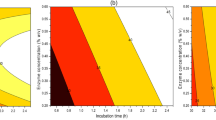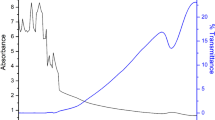Abstract
For simultaneous examination of the impacts of pulsed light (PL) treatment conditions (exposure time, distance of sample from light source and sample thickness) on microbial inactivation and total anthocyanin content of lactic acid fermented mulberry juice, response surface methodology was used. To determine the ideal processing parameter for PL treatment of the fruit juice, a three-factor face centered central composite design was used. The independent variables were: exposure time (4–12 s), sample’s proximity from light source (2–10 cm) and thickness of sample in the pulsation chamber (1–2 mm). Significant regression models describing the differences in total anthocyanin concentration and level of microbial inactivation with respect to the independent variables were generated with coefficient of determination (R2) greater than 0.90. The findings showed that the independent variables significantly impacted on the total anthocyanin concentration and level of microbial inactivation. The quadratic models exhibited regression coefficient, adjusted regression coefficient, lack of fit and adequate precision values greater than 0.9369, 0.8802, 0.5015 and 14.449 respectively. The face-centered central composite design showed that exposure length of 6.5 s, sample distance from light source of 10.00 cm, and sample width of 1.00 mm were the overall optimal PL treatment parameters. The optimum conditions resulted in a significant increase in TPC (982.30 mg/100 ml) and TFC (489.12 mg/100 ml) compared to the control (TPC: 929.47 mg/100 ml and TFC: 438.17 mg/100 ml) with no significant difference in the total anthocyanin concentration.






Similar content being viewed by others
Data Availability
Data will be provided upon request.
References
E. Malinowska-Pańczyk, Can high hydrostatic pressure processing be the best way to preserve human milk? Trends Food Sci. Technol. 101, 133–138 (2020)
W. Tchabo et al., Aroma profile and sensory characteristics of a sulfur dioxide-free mulberry (Morus nigra) wine subjected to non-thermal accelerating aging techniques. Food Chem. 232, 89–97 (2017)
W. Sitzmann, E. Vorobiev, N. Lebovka, Applications of electricity and specifically pulsed electric fields in food processing: historical backgrounds. Innov. Food Sci. Emerg. Technol. 37, 302–311 (2016)
Q.A. Syed et al., Pulsed electric field technology in food preservation: a review. J. Nutr. Health Food Eng. 6(6), 168–172 (2017)
A.M. Ziaiifar et al., Response surface optimization of pulsed electric field processed kiwi–carrot juice: enzyme inactivation and evaluation of physicochemical and nutritional properties. J. Food Meas. Charact. (2023). https://doi.org/10.1007/s11694-023-02164-4
H.L.A. Miñano et al., Magnetic fields in food processing perspectives, applications and action models. Processes 8(7), 814 (2020)
L. Guo et al., Germicidal efficacy of the pulsed magnetic field against pathogens and spoilage microorganisms in food processing: an overview. Food Control 136, 108496 (2022)
R. Mandal et al., Applications of pulsed light decontamination technology in food processing: An overview. Appl. Sci. 10(10), 3606 (2020)
M.S. Rahman, Food preservation: an overview, in Handbook of Food Preservation (CRC Press, Boca Raton, 2020), pp. 7–18
E. Kwaw et al., Effect of pulsed light treatment on the phytochemical, volatile, and sensorial attributes of lactic-acid-fermented mulberry juice. Int. J. Food Prop. 21(1), 213–228 (2018)
B. Madhu et al., Ultrasonic technology and its applications in quality control, processing and preservation of food: a review. Curr. J. Appl. Sci. Technol. 32(5), 1–11 (2019)
P. Torley, T. Truong, B. Bhandari, Ultrasound in food processing and preservation, in Handbook of Food Preservation (CRC Press, Boca Raton, 2020), pp. 733–756
B. Bhagat, S. Chakraborty, Potential of pulsed light treatment to pasteurize pomegranate juice: microbial safety, enzyme inactivation, and phytochemical retention. LWT 159, 113215 (2022)
R. Dhar, S. Basak, S. Chakraborty, Pasteurization of fruit juices by pulsed light treatment: a review on the microbial safety, enzymatic stability, and kinetic approach to process design. Compreh. Rev. Food Sci. Food Saf. 21(1), 499–540 (2022)
F. Xu et al., Optimization of spiral continuous flow-through pulse light sterilization for Escherichia coli in red grape juice by response surface methodology. Food Control 105, 8–12 (2019)
K. Vollmer et al., Effect of pulsed light treatment on natural microbiota, enzyme activity, and phytochemical composition of pineapple (Ananas comosus [L.] Merr.) juice. Food Bioprocess. Technol. 13, 1095–1109 (2020)
E. Kwaw et al., Impact of ultrasonication and pulsed light treatments on phenolics concentration and antioxidant activities of lactic-acid-fermented mulberry juice. LWT 92, 61–66 (2018)
M. Ferrario, S.M. Alzamora, S. Guerrero, Study of the inactivation of spoilage microorganisms in apple juice by pulsed light and ultrasound. Food Microbiol. 46, 635–642 (2015)
N.A. Maftei et al., Influence of processing parameters on the pulsed-light inactivation of Penicillium expansum in apple juice. Food Control 41, 27–31 (2014)
F. Charles et al., Pulsed light treatment as new method to maintain physical and nutritional quality of fresh-cut mangoes. Innov. Food Sci. Emerg. Technol. 18, 190–195 (2013)
L. Shaik, S. Chakraborty, Effect of pH and total fluence on microbial and enzyme inactivation in sweet lime (Citrus limetta) juice during pulsed light treatment. J. Food Process. Preserv. 46(8), e16749 (2022)
K.R. Avalos-Llano, O. Martín-Belloso, R. Soliva-Fortuny, Effect of pulsed light treatments on quality and antioxidant properties of fresh-cut strawberries. Food Chem. 264, 393–400 (2018)
M.H. Zenklusen et al., Inactivation of Aspergillus carbonarius and Aspergillus flavus in malting barley by pulsed light and impact on germination capacity and microstructure. Innov. Food Sci. Emerg. Technol. 45, 161–168 (2018)
B.-Y. Chen et al., Pulsed light sterilization of packaging materials. Food Packag. Shelf Life 5, 1–9 (2015)
V.M. Gomez-Lopez et al., Pulsed light for food decontamination: a review. Trends Food Sci. Technol. 18(9), 464–473 (2007)
E. Kwaw et al., Effect of fermentation parameters and their optimization on the phytochemical properties of lactic-acid-fermented mulberry juice. J. Food Meas. Charact. 11, 1462–1473 (2017)
I. Palgan et al., Effectiveness of high intensity light pulses (HILP) treatments for the control of Escherichia coli and Listeria innocua in apple juice, orange juice and milk. Food Microbiol. 28(1), 14–20 (2011)
E. Kwaw et al., Effect of lactobacillus strains on phenolic profile, color attributes and antioxidant activities of lactic-acid-fermented mulberry juice. Food Chem. 250, 148–154 (2018)
R.N. Alolga et al., Vacuum pressure combined with osmosonication as an innovative pre-drying technique for Ghanaian ginger: evidence from the metabolome and quality characteristics of the dried product. Ultrason. Sonochem. 80, 105841 (2021)
R. Osae et al., Influence of shea butter, bee wax and cassava starch coatings on enzyme inactivation, antioxidant properties, phenolic compounds and quality retention of tomato (Solanum lycopersicum) fruits. Appl. Food Res. 2(1), 100041 (2022)
E. Kwaw, A.S. Sackey, Nutritional and sensory analysis of millet based sponge cake. Int. J. Nutr. Food Sci. 2(6), 287–293 (2013)
A. Abedinia et al., Characterization and cell viability of probiotic/prebiotics film based on duck feet gelatin: a novel poultry gelatin as a suitable matrix for probiotics. Foods 10(8), 1761 (2021)
F.N. Engmann et al., The application of response surface methodology in studying the effect of heat and high hydrostatic pressure on anthocyanins, polyphenol oxidase, and peroxidase of mulberry (Morus nigra) juice. J. Sci. Food Agric. 94(11), 2345–2356 (2014)
K.F. McDonald et al., A comparison of pulsed and continuous ultraviolet light sources for the decontamination of surfaces. IEEE Trans. Plasma Sci. 28(5), 1581–1587 (2000)
M. Turtoi, A. Nicolau, Intense light pulse treatment as alternative method for mould spores destruction on paper–polyethylene packaging material. J. Food Eng. 83(1), 47–53 (2007)
M. Keyser et al., Ultraviolet radiation as a non-thermal treatment for the inactivation of microorganisms in fruit juice. Innov. Food Sci. Emerg. Technol. 9(3), 348–354 (2008)
S. Chakraborty et al., The potential of pulsed light treatment to produce enzymatically stable Indian gooseberry (Emblica officinalis Gaertn) juice with maximal retention in total phenolics and vitamin C. J. Food Process. Preserv. 44(12), e14932 (2020)
X. Hua et al., Novel physical treatments (pulsed light and cold plasma) improve the quality of postharvest apricots after long-distance simulated transportation. Postharvest. Biol. Technol. 194, 112098 (2022)
S. Chakraborty, P.V. Parab, Pulsed light treatment of table grape juice: influence of matrix pH on microbial and enzyme inactivation kinetics. Food Biosci. 53, 102662 (2023)
Q. Zhang et al., Dietary protein-phenolic interactions: Characterization, biochemical-physiological consequences, and potential food applications. Crit. Rev. Food Sci. Nutr. 61(21), 3589–3615 (2021)
R. Modi, P. Sahota, G. Pandove, Lactic acid fermentation of Amla-Indian gooseberry blend: enhancing antioxidants and developing a novel bio-intervention. J. Food Meas. Charact. (2023). https://doi.org/10.1007/s11694-023-02154-6
Acknowledgements
We would like to acknowledge all those who supported us.
Author information
Authors and Affiliations
Corresponding authors
Ethics declarations
Conflict of interest
The authors affirm no conflict of interest.
Additional information
Publisher's Note
Springer Nature remains neutral with regard to jurisdictional claims in published maps and institutional affiliations.
Rights and permissions
Springer Nature or its licensor (e.g. a society or other partner) holds exclusive rights to this article under a publishing agreement with the author(s) or other rightsholder(s); author self-archiving of the accepted manuscript version of this article is solely governed by the terms of such publishing agreement and applicable law.
About this article
Cite this article
Kwaw, E., Osae, R., Apaliya, M.T. et al. Effect of optimized pulsed light treatment conditions on microbiological safety, phytochemical and sensory properties of lactic-acid-fermented mulberry juice. Food Measure 18, 1878–1888 (2024). https://doi.org/10.1007/s11694-023-02306-8
Received:
Accepted:
Published:
Issue Date:
DOI: https://doi.org/10.1007/s11694-023-02306-8




